Note: The reasons for the L.L. Certificate having been issued "interim" only were
(a) the "temporary" stability booklet which was not approved by B.V. (on behalf of the Estonian Board of Navigation);
(b) the too small cross-flooding valve between the heeling tanks.
The reason why the PSSC was issued wrongly was the fact that the vessel did not comply with the requirements of SOLAS 1974 for the "intended trade", i.e. proceeded more than 20 nm from the nearest land, as stated annually in the "Survey Report for the Issue for PSSC - Clause 1 - General Information" and, thus, the bow ramp plus front bulkheads, as upper extension of the collision bulkhead above bulkhead deck = car deck, were ca. 5.8 m too much forward (see Subchapter 2.4.4 above).
The last issued L.L. Certificate had already expired on 11.09.94 and apparently a further interim one had not been issued by B.V. for reasons unknown to this 'Group of Experts'. In any event, according to the certificates issued after the surveys carried out between the 23-25 August 1994 by Anders Wirstam, the Load Line Survey was apparently carried out and Annex A - to Report No. STK/94/77E - see Enclosure 16.1.206 - was filled out although, as it looks, no new Interim L.L. Certificate had been issued by the time of the casualty.
This was, at least, the situation in October/November 1994, since it has to be assumed that N&T would have submitted the L.L. Certificate valid at the time of sinking, had they had it. However, when the Final Report of the Joint Accident Investigation Commission was published, it was most surprising to note that they stated on page 46, item 3.6.2 that there had been a valid L.L. Certificate issued on 9 September 1994. In any event, also this certificate was issued falsely because visor and bow ramp had been leaking for many months before the casualty.
Based on the status of the class and safety certificates only, it could be assumed that the vessel ESTONIA was in an acceptable condition when she departed from Tallinn on 27 September 1994. This, however, was definitely not the case as will be demonstrated in the following subchapters.
16.2
Condition of the Bow Area
Based on the information contained in the previous chapters 3.5 and 12 regarding the vessel's performance until 27 September 1994, in particular the various observations of passengers, crew members and other persons on or from the car deck or other decks of the ferry, it has to be concluded that
(1) the visor,
its locking devices (hinges) and rubber packings;
(2)
the bow ramp, its locking devices, hinges and rubber packings
had been in a very bad condition respectively were non-existent when the ferry
commenced her last voyage on the evening of 27 September 1994.
This conclusion is in direct contradiction to the statements made by Bureau Veritas in the many certificates issued by them in respect of all the safety relevant parts of the vessel and it is indeed the question on what basis these certificates have been issued.
Before the observed deficiencies shall be explained in detail the relevant parts of the foreship, which played a crucial role in the casualty sequence-of-events, shall be shown below and on the following page again for easy reference.
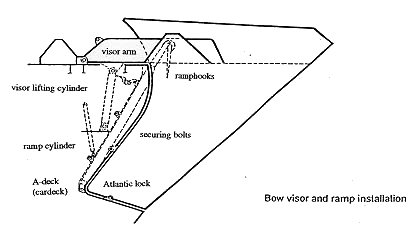
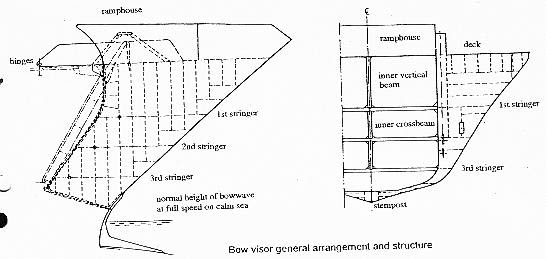
In addition, these deficiencies are shown on a drawing of the foreship with open visor which is integrated into this report and forms the following page.
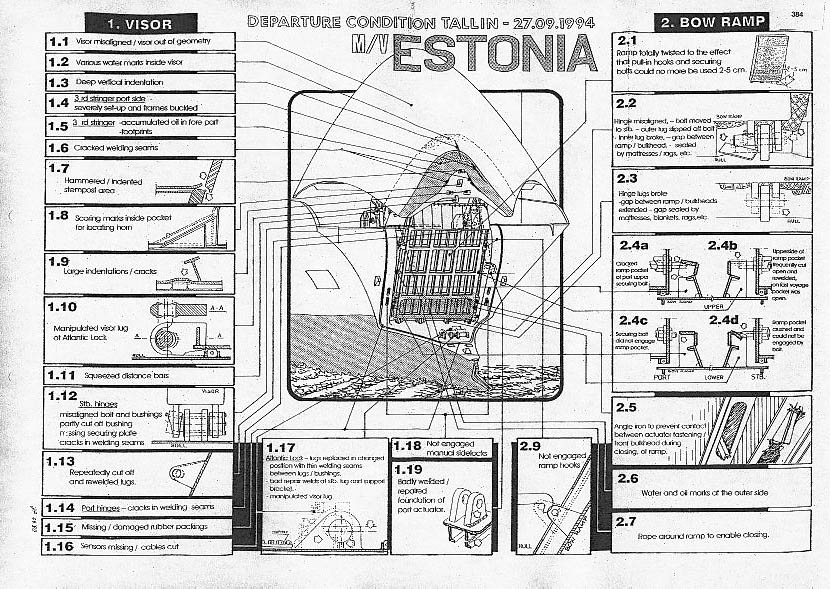
In detail:
(1) The visor, its hinges, locking devices and rubber packings:
In detail:
The problems with the visor were initiated by two different circumstances,
viz.
- severe structural damage
caused by proceeding through heavy ice at excessive speed.
- the decision of the Technical Managers, N&T, not to renew the rubber packings,
assuring weather(water-)tightness of the visor and preventing the visor from
vibrating and thereby avoiding cracks emanating therefrom.
Structural damage:
The shell plating as well as the internals are very severely damaged in two places, viz. there is a deep vertical indentation in the bow leading upwards from the stempost for about 2 m, as can be seen on the picture below from the outside,
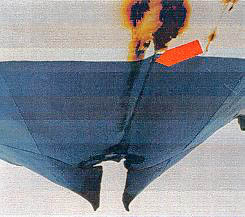
The arrow points to the deep indentation which is completely painted and the paint does not show contact marks. The following photos showing the inside of the same area do confirm the deep indentation in a very strong part of the visor to be of old origin.
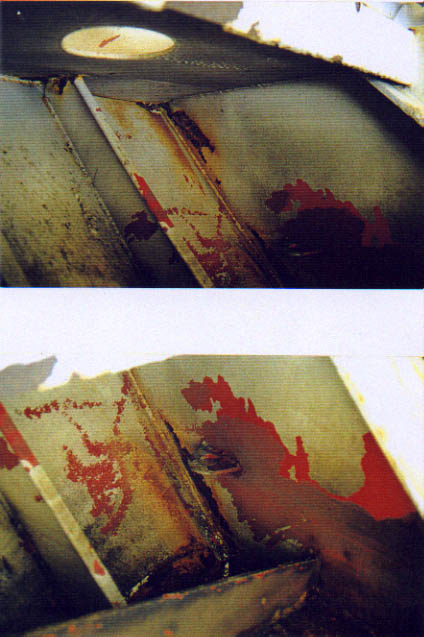
Furthermore, the shell plating as well as the 3rd stringer at the port side are severely indented and set up with the frames buckled which had been sustained already some time before the casualty. - See the pictures above.
The condition of the visor bottom with stempost is evident from the picture below taken on 30.08.94.
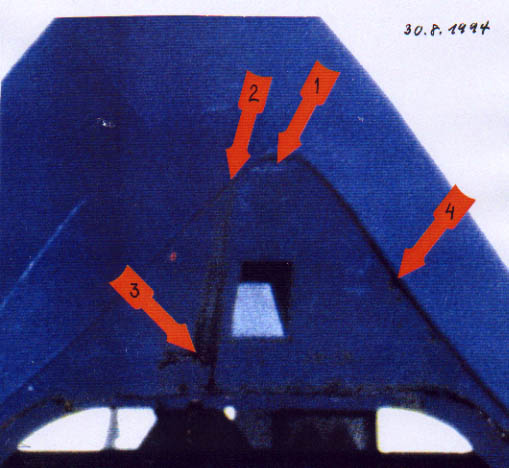
Arrow 1 - Indentation in the foremost part of the visor bottom indicating that the visor's initial position was changed to forward most probably due to misalignment of the whole structure. This led to contact between the visor bottom and the stempost on the forepeak deck. Since the visor bottom in this area is not constructed to take up load, the bottom became indented and cracked.
Arrow 2 - Indicates a cracked welding seam through which water penetrated and created the rust stripes.
Arrow 3 - Indicates transverse cracks in the visor bottom in way of the contact area with the starboard steel pad welded to the forepeak deck and which should take up about 10% of the visor's weight in closed condition. Since the corresponding port side is not affected at all, it has to be assumed that the starboard side absorbs all the weight which is another indication for the complete misalignment of the visor.
Arrow 4 - Indicates a further probably cracked area.
In summary of the
above it has to be concluded that the visor was completely misaligned in longitudinal,
transverse and vertical direction which led to considerable problems during
opening and closing. These problems increased all the more as time went by
as confirmed by the many observations, e.g. of previous passengers, in particular
the truck drivers having spent hours on the car deck waiting for the crew
to be able to open the visor (see Subchapter 12.4.3 above).
The difficulties
with the visor are also confirmed by previous crew members and pilots having
observed the frequent opening and violent closing until the locating horn
on the forepeak deck (pyramid) finally fitted into the mating pocket in the
visor bottom (see Subchapter 12.4.3 above).
Consequences of
the misaligned visor
Due to the increasing misalignment it was at first difficult to close the
locking devices and subsequently to open them.
Reportedly it had not been possible to open and close the Atlantic lock
hydraulically for several months prior to the casualty and the crew members
had to go inside the visor before arrival and after departure from Tallinn
and hammer open respectively closed the bolt of the Atlantic lock which, among
other things affected the load-carrying capacity of the lugs. Also the hydraulic
side locks were difficult to close and subsequently to open. Reportedly
on many occasions after arrival in Tallinn the lugs had to be cut off the
visor by flame-cutting to be able to open the visor. Subsequently the lugs
were rewelded to the visor bulkheads which continuously reduced the load-carrying
capacity of these lugs (see Subchapter 12.4.3. and Chapter 30).
Obviously also
the visor hinges had become affected because on 17 September 1994,
i.e. 10 days before the last departure, a passenger filmed the visor and,
in particular, the starboard visor hinges in Tallinn during the closing procedure.
The passenger
was standing in front of deck 7 and filmed the closing of the visor, finally
zooming in on the starboard hinges. The video-prints below are part of the
film. Picture 2 is an enlargement of Picture 1.
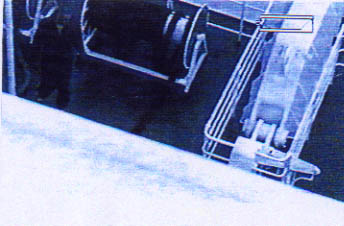
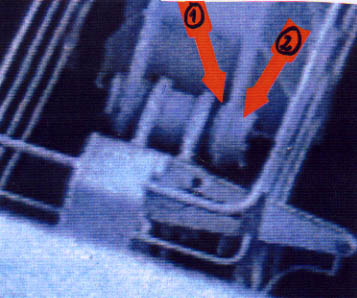
On Picture 2 there are obviously several major deficiencies visible, viz.
(a) the gap between the starboard vessel hinge plate and the outer bushing is much too large (arrow 1).
(b) the outer bushing is sticking much too far out of the outer visor hinge plate (arrow 2) [which explains the large gap mentioned above].
(c) the lower part of outer bushing is missing.
(d) the securing plate is missing and the outer end of the bolt is not visible.
(e) the outer bushing appears to be twisted anti-clockwise.
(f) the inner bushing
appears to be twisted clockwise.
See also Subchapters 12.4.3, 12.5 and Chapter 30.
All this indicates
that the steel- and bronze-bushings of the starboard visor hinge arrangement
had been replaced some time ago in a very unpro-fessional way with an extremely
poor standard of workmanship.
Also the member of a working team, the nautical student Rain Oolmets, who
stayed on board from 15 July to 11 September 1994, had discovered cracks in
the welding seams up to 10 cm long between the steel bushings and the visor
hinge plates of the port and starboard visor hinge arrangements which underlines
the generally poor condition of these safety relevant components. See Subchapter
12.5.
It is obvious from the above description of the visible deficiencies that
the condition of the visor hinges rendered the vessel already initially
unseaworthy.
Consequences of
missing rubber packings
The last
Finnish crew had requested the renewal of 15 m of rubber packing in way of
the visor for the then planned yard time in January 1993, because the rubber
packing had last been renewed in January 1991. This meant a renewal of the
entire packing on the forepeak deck plus about 2 m up each front bulkhead
as demonstrated by the following drawing.
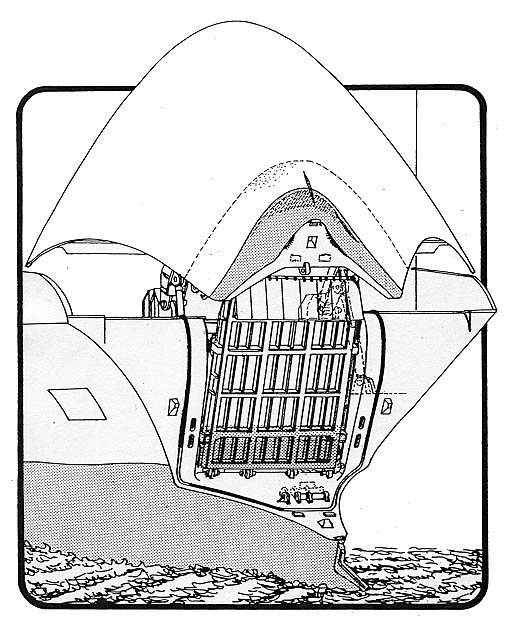
Since the new technical
managers N&T were of the opinion that visors are full of water at sea anyway,
the rubber packings were not renewed in January 1993 and also not later. This
means that the visor became quickly filled up with water at sea up to the
height of the outside water level. In calm sea it was the height of the bow
wave which filled the visor up to the 3rd stringer, however, the worse the
weather was and the deeper the bow was diving into the waves, the higher the
water rose inside the visor.
The following
picture shows the ESTONIA in Tallinn, with open visor but closed bow ramp
so that the otherwise invisible underside of the bow ramp is shown with the
lowest section being dark - see arrow. Doubtless this was caused by the water
inside the visor with hydraulic oil from the leaking cylinders swimming on
top of the water surface. When the vessel reduced speed and the bow wave became
smaller and finally disappeared completely when the vessel was alongside,
the water streamed out of the visor and the oil settled everywhere inside
the visor, also on the bow ramp which forms the aft inside of the visor.
The water streaming
out of the visor was observed by many passengers when the vessel was alongside
in Stockholm with closed visor and, among others, also by the skipper of the
Sandhamn pilot boat as well as by several pilots when the ferry was
slowing down during
the approach to the pilot boat.
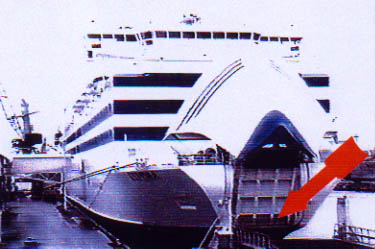
The bow wave became
smaller and the water streamed at once out of the visor. (See Subchapter 12.4.4.)
It is obvious
that at sea inside the visor the conditions in a partly filled ballast water
tank did exist with resultant sloshing effects causing additional loads on
hinges and locking devices and vibrations to the whole visor, the consequences
of which are described in Subchapter 34.3.
(2) The bow ramp,
its locking devices, hinges and rubber packings:
The
bow ramp was part of the upper extension of the collision bulkhead above
bulkhead deck and as such had to be mandatorily watertight based on the stringent
requirements of SOLAS 1974. This, however, was obviously not the case because
back to December 1993 there is reliable evidence that frequently there had
been a lot of water on the car deck - see Subchapter 12.4.4. There is also
a lot of evidence that the bow ramp was severely misaligned and - in fact
- was no more connected to the port outer and probably also inner hinges for
some time - see Subchapter 12.4.3. It has thus to be assumed that the water
penetrated onto the car deck from the visor, which was filled up to the outside
water level, as soon as the vessel was on full speed and the bow wave had
risen to ca. 2.5 m height. Since even in calm sea the visor was filled above
the level of the 3rd stringer, which is above the car deck level, it is apparent
that even in good weather conditions water was streaming onto the car deck.
Most of it was most probably absorbed by the 12 scuppers at each side, some
of which, however, were reportedly always blocked by stones and other debris.
Consequently it has to be assumed that there was already a deadly connection
between the always water-filled and -refilled visor and the large, open car
deck via the open port lower edge of the bow ramp since some time before
the last departure.
The locking devices
of the bow ramp were difficult to lock and, once locked, even more difficult
to unlock. There is lots of evidence from truck drivers and other passengers
having waited for hours on the car deck watching the fruitless attempts to
open respectively close the securing bolts hydraulically and, finally, watching
them being opened by flame cutting of the upper parts of the mating boxes,
which should have been subsequently rewelded but frequently were not. When
the crew did not succeed in closing the bolts hydraulically, they tried it
by hammering, even by using sledge-hammers and very often gave up, i.e. the
ramp remained - at least partly - unsecured! (See Subchapters 12.4.3 / 12.4.5.)
All this led,
of course, in time to a considerable reduction of the load-carrying capacity
similar as with the hydraulic side locks of the visor. Also the hinges
of the bow ramp were severely affected, in particular the port outer
hinge. This very heavy hinge arrangement was already damaged before the
vessel was taken over by her new owners in January 1993, because the old Finnish
crew had already requested renewal at the planned yard time in January 1993
- see Subchapter 6.5.1. Nothing was done by N&T and since the mates of the
ESTONIA performed the loading and discharging of the cars and trucks reportedly
rather carelessly, the vessel very often had a list during loading or unloading
which finally broke the port hinge completely according to the report of a
truck driver being an eye witness.
The crew had
severe problems to lift up the ramp at all which was only possible after some
temporary measurements had been carried out. Ever since, the misalignment
of the ramp increased visibly and the problems were growing daily.
Also the rubber
packings around the car deck opening, which should be sealed tight by
a properly closed and locked bow ramp, apparently did no more seal watertight
since some considerable time already, because the last Finnish crew had ordered
10 m of rubber packing to be renewed at the next yard time which was planned
for January 1993 - see Subchapter 3.4. - as mentioned before. This was more
than half of the total length of the rubber packings, but also these packings
were never renewed.
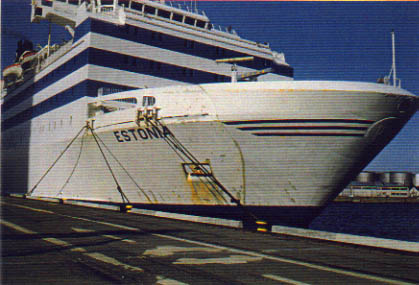
![]()